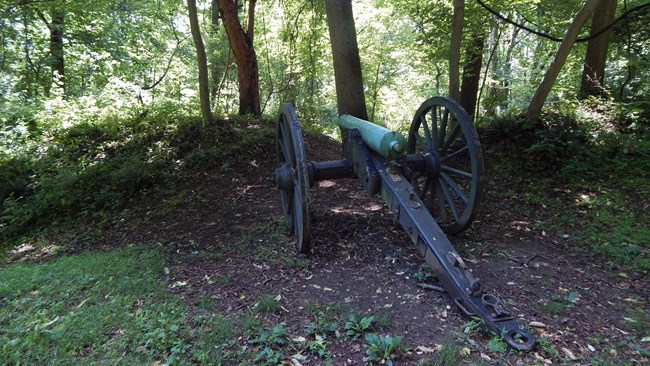Last updated: March 1, 2021
Article
Cultural Landscapes & Natural Resource Collaboration

NPS/S. Phan
Julie McGilvray, NCA Historical Landscape Architect
It has long been a goal to bring natural and cultural resource disciplines more closely together within the National Park Service. NPS employees charged with managing diverse park resources, capably move across a wide array of disciplines to, “preserve unimpaired the natural and cultural resources and values of the National Park System for the enjoyment, education, and inspiration of this and future generations”. In the National Capital Area, efforts are currently underway to bring the two “sides of the house” closer together in support of more integrated park resource management through project opportunities. One of which is a phased study of earthworks in and around Washington DC. The study begins with a management plan for the Civil War Defenses of Washington and will continue with work at Harpers Ferry and battlefields in years out. Through this project and others, we are learning how to work together to better integrate data and disciplines.
The field of Cultural Landscape studies, while housed in cultural resources within the NPS, is interdisciplinary in theory and practice and offers a potential platform for more integrated resource work. The concept can be traced to the field of geography and was first articulated in the 1925 Morphology of Landscape by Carl Sauer. His groundbreaking definition stated, “Culture is the agent, the natural area is the medium. The cultural landscape the result’. Cultural Landscapes became part of the NPS body of practice throughout the 1980s with the development of the Cultural Landscape Report (CLR). Cultural Landscapes were adopted as a cultural resource “type” in the 1990s.
The Cultural Landscape concept, as applied by the NPS, offers a way to study the evolution of a landscape or rather how humans have shaped their environments over time and how that environment has shaped cultural responses. For the NPS, a landscape studied through this lens must have historical significance. Thus, cultural landscapes not only look at the land and how it has been shaped by people (roads, buildings, gardens, etc.), but it also incorporates data from archeology, soils, history, geology, cultural anthropology and ethnography (traditional land uses and cultural traditions), ecology (vegetation, natural systems, climate), and views and vistas through thirteen cultural landscape characteristics. These characteristics allow analysis to be as comprehensive as possible for a given place (See Figure 1 for a full list of Cultural Landscape characteristics). Further, they are used to create a statement of landscape character, which drives what should be preserved about an area. This kind of “kitchen sink” approach allows for collaboration that doesn’t exist within other disciplines in cultural resources.
Figure 1. Thirteen Recommended Cultural Landscape Characteristics:
Spatial Organization
Land Use
Cultural Traditions
Cluster Arrangement
Circulation
Topography
Vegetation
Buildings and Structures
Views and Vistas
Constructed Water Features
Small Scale Features
Archeological Sites
The effort to align cultural and natural resources in the context of cultural landscapes can be a key component of all Cultural Landscape Reports (CLRs) and Cultural Landscape Inventories (CLIs). Recent positive changes in quantitative data coming from natural resource programs (in part due to the NPS Inventory & Monitoring Division) continues to push this alignment, providing natural resource data that has the potential to support and help us better understand the more qualitative aspects of historic landscapes. More integrated studies through cultural landscapes may be used to balance protection of cultural and natural resources in a given park or area within a park.
What is a Cultural Landscape?
Cultural landscapes are places that according to NPS-28 Cultural Resource Management Guideline (emphasis added):
"are complex resources that range from large rural tracts covering several thousand acres to formal gardens of less than an acre. Natural features such as landforms, soils, and vegetation are not only part of the cultural landscape, they provide the framework within which it evolves.
A cultural landscape is a reflection of human adaptation and use of natural resources and is often expressed in the way land is organized and divided, patterns of settlement, land use, systems of circulation, and the types of structures that are built.
The character of a cultural landscape is defined both by physical materials such as roads, buildings, walls, and vegetation, and also by use reflecting cultural values and traditions."
About Cultural Landscapes in the National Capital Area
he National Capital Area has 250 identified cultural landscapes that range greatly in size, character, and significance. 88 of these cultural landscapes have been documented. On the larger end, a 2008 Cultural Landscape Inventory identified all of Catoctin Mountain Park as a cultural landscape in that
“bears the imprint of two historic periods. The first (1770-1903) is the span of years during which the landscape was utilized by the nearby iron furnace, an example of the nation’s early iron industry. In the second period of significance (1934-1942), a portion of the mountain landscape was recast for recreation and conservation when the federal government developed it as a recreational demonstration area (RDA)”
On the smaller end, Stanton Park, within National Capital Parks-East is a cultural landscape and public park created as part of the implementation of the L'Enfant Plan for the City of Washington.
Visit the NCA Cultural Landscape webpage to learn more about the program, or to access links to Cultural Resource Inventories and Reports.
